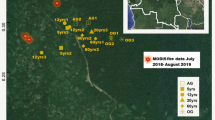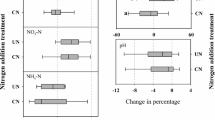Abstract
The deposition of nitrogen (N) is high in subtropical forest in South China and it is expected to increase further in the coming decades. To assess effects of increasing deposition on N cycling, we investigated the current N status of two selected 40–45-year-old masson pine-dominated Chinese subtropical forest stands at Tieshanping (TSP, near Chongqing City) and Caijiatang (CJT in Shaoshan, Hunan province), and explored the applicability of several indicators for N status and leaching, suggested for temperate and boreal forest ecosystems. Current atmospheric N deposition to the systems is from 25 to 49 kg ha−1 year−1. The concentration of total N in the upper 15 cm of the soil is from as low as 0.05% in the B2 horizon to as high as 0.53% in the O/A horizon. The concentration of organic carbon (C) varies from 0.74 (B2) to 9.54% (O/A). Pools of N in the upper 15 cm of the soils range from 1460 to 2290 kg N ha−1, where 25–55% of the N pool is in the O/A horizon (upper 3 cm of the soil). Due to a lack of a well-developed continuous O horizon (forest floor), the C/N ratio of this layer cannot be used as an indicator for the N status, as is commonly done in temperate and boreal forests. The net N mineralization rate (mg N g−1 C year−1) in individual horizons correlates significantly with the C/N ratio, which is from as high as 18.2 in the O/A horizon to as low as 11.2 in the B2 horizon. The N2O emission flux from soil is significantly correlated with the KCl extractable NH +4 –N in the O/A horizon and with the net nitrification in the upper 15 cm of the soil. However, the spatial and temporal variation of the N2O emission rate is high and rates are small and often difficult to detect in the field. The soil flux density of mineral N, defined as the sum of the throughfall N input rate and the rate of in situ net N mineralization in the upper 15 cm of the soil, i.e., the combination of deposition input and the N status of the system, explains the NO −3 leaching potential at 30 cm soil depth best. The seasonality of stream water N concentration at TSP and CJT is climatic and hydrologically controlled, with highest values commonly occurring in the wet growing season and lowest in the dry dormant season. This is different from temperate forest ecosystems, where N saturation is indicated by elevated NO −3 leaching in stream water during summer.








Similar content being viewed by others
References
Aber J, McDowell W, Nadelhoffer K, Magill A, Berntson G, Kamakea M, McNulty S, Currie W, Rustad L, Fernandez I (1998) Nitrogen saturation in temperate forest ecosystems—hypotheses revisited Bioscience 48:921–934
Aber JD, Goodale CL, Ollinger SV, Smith ML, Magill AH, Martin ME, Hallett RA, Stoddard JL (2003) Is nitrogen deposition altering the nitrogen status of northeastern forests? Bioscience 53:375–389
Ågren GI, Bosatta E (1988) Nitrogen saturation of terrestrial ecosystems. Environ Pollut 54:185–197
Andersson P, Berggren D, Nilsson I (2002) Indices for nitrogen status and nitrate leaching from Norway spruce (Picea abies (L.) Karst.) stands in Sweden. Forest Ecol Manage 157:39–53
Bengtsson G, Bengtsson P, Mansson KF (2003) Gross nitrogen mineralization-, immobilization-, and nitrification rates as a function of soil C/N ratio and microbial activity. Soil Biol Biochem 35:143–154
Bouwman AF, Fung I, Matthews E, John J (1993) Global analysis of the potential for N2O production in natural soils. Global Biogeochem Cycles 7:557–597
Breuer L, Papen H, Butterbach-Bahl K (2000) N2O emission from tropical forest soils of Australia. J Geophy Res-Atmos 105:26353–26367
Butterbach-Bahl K, Gasche R, Breuer L, Papen H (1997) Fluxes of NO and N2O from temperate forest soils: impact of forest type, N deposition and of liming on the NO and N2O emissions. Nutr Cycling Agroecosyst 1–2:79–90
Butterbach-Bahl K, Rothe, Papen H (2002) Effect of tree distance on N2O and CH4-fluxes from soils in temperate forest ecosystems. Plant Soil 240(1):91–103
Chen XY, Mulder J, Wang YH, Zhao DW, Xiang RJ (2004) Atmospheric deposition, minerlization and leaching of nitrogen in subtropical forested catchments, South China. Environ Geochem Health 26:179–186
Currie WS (1999) The responsive C and N biogeochemistry of the temperate forest floor. Trends Ecol Evol 14:316–320
Dise NB, Wright RF (1995) Nitrogen leaching from European forests in relation to nitrogen deposition. Forest Ecol Manag 71:153–161
Dise NB, Matzner E, Gundersen P (1998a) Synthesis of nitrogen pools and fluxes from European forest ecosystems. Water Air and Soil Pollut 105:143–154
Dise NB, Matzner E, Forsius M (1998b) Evaluation of organic horizon C:N ratio as an indicator of nitrate leaching in conifer forests across Europe. Environ Pollut 102:453–456
Emmett BA, Boxman D, Bredemeier M, Gundersen P, Kjonaas OJ, Moldan F, Schleppi P, Tietema A, Wright RF (1998) Predicting the effects of atmospheric nitrogen deposition in conifer stands: evidence from the NITREX ecosystem-scale experiments. Ecosystems 1:352–360
Fenn ME, Poth MA, Johnson DW (1996) Evidence for nitrogen saturation in the San Bernardino Mountains in southern California. Forest Ecol Manag 82:211–230
Fernandez IJ, Simmons JA, Briggs RD (2000) Indices of forest floor nitrogen status along a climate gradient in Maine, USA. Forest Ecol Manag 134:177–187
Galloway J, Cowling E, Kessler E (2002) Reactive nitrogen. Ambio 31:59
Gundersen P (1991) Nitrogen deposition and the forest nitrogen-cycle—role of denitrification. Forest Ecol Manag 44:15–28
Gundersen P, Emmett BA, Kjonaas OJ, Koopmans CJ, Tietema A (1998a) Impact of nitrogen deposition on nitrogen cycling in forests: a synthesis of NITREX data. Forest Ecol Manag 101:37–55
Gundersen P, Callesen I, de Vries W (1998b) Nitrate leaching in forest ecosystems is related to forest floor C/N ratios. Environ Pollut 102:403–407
Hall SJ, Matson PA (2003) Nutrient status of tropical rain forests influences soil N dynamics after N additions. Ecol Monogr 73:107–129
Hao JM, Tian HZ, Lu YQ (2002) Emission inventories of NOx from commercial energy consumption in China, 1995–1998. Environ Sci Technol 36:552–560
Larssen T, Tang D, He Y (eds) (2004) Integrated monitoring program on acidification of Chinese terrestrial systems—IMPACTS—Annual report results 2003. NIVA Report 4905-2004. NIVA, Oslo, Norway
MacDonald JA, Dise NB, Matzner E, Armbruster M, Gundersen P.and Forsius M (2002) Nitrogen input together with ecosystem nitrogen enrichment predict nitrate leaching from European forests. Global Change Biol 8:1028–1033
Maithani K, Arunachalam A, Tripathi RS, Pandey HN (1998) Nitrogen mineralization as influenced by climate, soil and vegetation in a subtropical humid forest in northeast India. Forest Ecol Manag 109:91–101
Matson PA, McDowell WH, Townsend AR, Vitousek PM (1999) The globalization of N deposition: ecosystem consequences in tropical environments. Biogeochemistry 46:67–83
Mitchell MJ, Iwatsubo G, Ohrui K, Nakagawa Y (1997) Nitrogen saturation in Japanese forests: an evaluation. Forest Ecol Manag 97:39–51
Ohrui K, Mitchell MJ (1997) Nitrogen saturation in Japanese forested watersheds. Ecol Appl 7:391–401
Ollinger SV, Smith ML, Martin ME, Hallett RA, Goodale CL, Aber JD (2002) Regional variation in foliar chemistry and N cycling among forests of diverse history and composition. Ecology 83:339–355
Oura N, Shindo J, Fumoto T, Toda H, Kawashima H (2001) Effects of nitrogen deposition on nitrous oxide emissions from the forest floor. Water Air Soil Pollut 130:673–678
Parsons DAB, Scholes MC, Scholes RJ, Levine JS (1996) Biogenic NO emissions from savanna soils as a function of fire regime, soil type, soil nitrogen, and water status. J Geophy Res-Atmos 101: 23683–23688
Post WM, Pastor J, Zinke PJ, Stangenberger AG (1985) Global patterns of soil-nitrogen storage. Nature 317:613–616
Schulze E-D (ed) (2000) Carbon and nitrogen cycling in European forest ecosystems. Ecological studies, vol. 142. Springer
Sitaula BK, Bakken LR, Abrahamsen G (1995) Nutrient balance in Scots pine (Pinus sylvestris L.) forest. 3. Fluxes of N2O from lysimeter as influenced by nitrogen input. Water Air Soil Pollut 85:1155–1159
Stoddard JL (1994) Long-term changes in watershed retention of nitrogen—its causes and aquatic consequences. Environ Chem Lakes Reservoirs 237:223–284
Theodose TA, Martin J (2003) Microclimate and substrate quality controls on nitrogen mineralization in a New England high salt marsh. Plant Ecol 167:213–221
Tietema A, Beier C, deVisser PHB, Emmett BA, Gundersen P, Kjonaas OJ, Koopmans CJ (1997) Nitrate leaching in coniferous forest ecosystems: the European field-scale manipulation experiments NITREX (nitrogen saturation experiments) and EXMAN (experimental manipulation of forest ecosystems). Global Biogeochem Cycles 11:617–626
Vitousek PM, Matson PA (1988) Nitrogen transformations in a range of tropical forest soils. Soil Biol Biochem 20:361–367
Wright RF, Beier C, Cosby BJ (1998) Effects of nitrogen deposition and climate change on nitrogen runoff at Norwegian boreal forest catchments: the MERLIN model applied to Risdalsheia (RAIN and CLIMEX projects). Hydrol Earth Syst Sci 2:399–414
Zhao DW, Wang AP (1994) Estimation of anthropogenic ammonia emissions in Asia. Atmos Environ 28:689–694
Zhu ZL, Chen DL (2002) Nitrogen fertilizer use in China—contributions to food production, impacts on the environment and best management strategies. Nutr Cycling Agroecosyst 63:117–127
Acknowledgments
We thank all partners of the Sino-Norwegian IMPACTS project, in particular project coordinators Tang Dagang (Chinese Research Academy of Environmental Sciences), and Espen Lydersen (Norwegian Institute for Water Research). Financial support for the IMPACTS was received from NORAD, the Norwegian Agency for Development Cooperation, from the State Environmental Protection Agency (SEPA) in Beijing, as well as from the provincial Environmental Protection Bureaus (Chongqing and Changsha for nitrogen study). The manuscript benefited greatly from two anonymous reviewers.
Author information
Authors and Affiliations
Corresponding author
Rights and permissions
About this article
Cite this article
Chen, X.Y., Mulder, J. Indicators for nitrogen status and leaching in subtropical forest ecosystems, South China. Biogeochemistry 82, 165–180 (2007). https://doi.org/10.1007/s10533-006-9061-3
Received:
Accepted:
Published:
Issue Date:
DOI: https://doi.org/10.1007/s10533-006-9061-3




